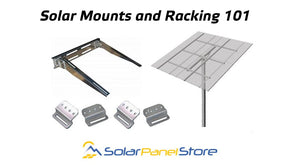Solar Panel Store Blog — Solar Mounts and Racking

Solar Mounts and Racking 101
To mount or not to mount? No, that's not really the question when it comes to solar panels. You pretty much have to secure them to something. The question is what solar mounting racks are available and how do you choose which one is right for you?
Type.
Solar panel type or construction will often drive your options for solar PV mounting structures. Most solar panels these days are rigid, aluminum-framed, tempered-glass covered silicon modules. These types of solar panels will mount differently than thin-filmed modules which may be comprised of semi-flexible, plastic sheets. Semi-flexible sheets can be glued to house roofs, RV roofs, boat decking, you name it. They can handle curved surfaces well, and it's always nice to minimize holes in a roof. If you're looking for a good adhesive, check out our Sikaflex sealant page. Whereas, rigid aluminum-framed modules are designed to be clamped down to rails using special hardware and racking equipment described below. Sometimes people will screw through the frames to secure modules to home-made racking or frames, but that method is more common for small backyard projects like pumps, etc.Roof.
Mounting solar panels to a residential or commercial roof is extremely common and a number of racking manufacturers offer solar panel mount solutions to fit most any type or pitch roof. From ballast systems for flat residential or commercial roofs, to specialized fittings for asphalt shingle, standing-seam metal or clay tile roofs there is a solution for you! While most roof racking involves securing an L-shaped "foot" to the roof surface, and securing horizontal "rails" to the feet, onto which solar panels are clamped, there also "rail-less" options as well. Rail-less essentially involve attaching a set of feet to the roof and then securing a panel to a set of feet without rails. Rail-less solar mounting racks are desired sometimes for aesthetics and for certain locations that make rails impractical. So should you mount solar panels to your roof? Roof mounting is a great option when space or sunny options are limited. And that's probably why most residential installations are roof-mounted. Not everyone has enough sunny yard space to make a ground mount possible or desirable. It also avoids the additional expense and effort to trench for longer conductor runs and set post or poles necessary when ground mounting. You’ll want or need (depending on your local building requirements) to inspect your roof’s structure engineering to confirm it can support a solar PV mounting structure. Also inspect your roof's condition and make any repairs before installing a solar array. Fire codes also often have set-back requirements to ensure the perimeter of the roof is accessible for firefighters.Ground.
Solar panel mounts for the ground arrays come in two flavors: fixed and "top-of-pole" mounts. Either offers some benefits over roof solar mounting racks. Panels mounted on the ground will be cooler than on a roof, which helps maximize voltage and energy production a bit. They are also more accessible should you have any issues--which is rare. And some mounting options allow you to adjust the tilt of the array as the seasons change. Ground mounts can be placed in optimal sun, tilt and orientation to generate the maximum energy. Contrast to roof mounts that are usually flush mounted to the roof's tilt and direction (which is usually not ideal). Both fixed and pole mounts will require trenching to run buried conductors, and digging proper foundations. A fixed mount system may be a little more manageable as a DIY project. And manufacturers like SnapNRack provide the design layout and parts akin to a tinker toy set! That said, a pole mount may ofter the benefit of adjustability. Pole mounts can also be combined with a "tracker" feature that rotates the array throughout the day to follow the sun. Trackers can generate a bit more energy production than a fixed array. But with low panel prices, we have found that the cost and maintenance (moving parts break) can be offset by just oversizing your array by a panel or two.RV & Boat
Mounting solar panels on an RV roof or boat roof or deck is usually a little different than for typical residential or commercial roofs, so we have a separate page for solar panel mounts for RVs on our site. We already discussed adhering semi-flexible panels above. Rigid solar panels are individually mounted to an RV or boat roof using a set of Z-brackets, or to a tilt-mount bracket or a set of corner molded brackets glue to the roof and in turn screw into the aluminum frames for a rock solid mount. We also have a nice Go Power Cable Entry Plate that mounts over the roof hole and neatly connects to all solar panel leads--nice and clean.Side-of-Pole.
There are many types of industrial, farm or other remote power installations where 1-2 panels need to be mounted near the remote equipment (like pumps, lights, sensors, monitors, other instruments). So our Side Of Pole page shows a variety of solar panel mounts that connect to an existing pole. Typically a battery box can be mounted on the same pole to house the battery, charge controller and wiring. Many of these solar mounting racks can also be screwed into a horizontal wall (like a shed for example) and can be tilted as well. Often the less expensive mounts work best for 36 cell, 12 volt panels. But there are options for the larger 60 cell panels as well.Mounts and Racking Products.
Check out our Solar Mounts and Racking. We'd be happy to help you find the specific mounting solution to fit your needs. Give us a call!- Thomas Lindberg
- Tags: Mounts Racking Solar Basics Solar Mounts and Racking

